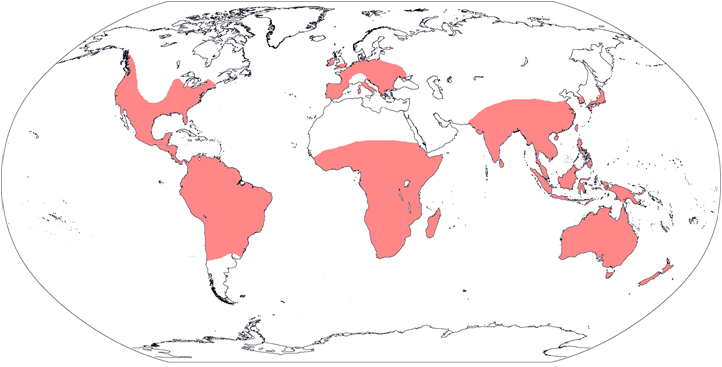Azolla occurs naturally in freshwater ditches, ponds, lakes and sluggish rivers of warm-temperate and tropical regions.
Its absence from regions that have prolonged freezing or aridity, both of which are fatal to Azolla, is clearly illustrated by Small & Darbyshire’s (2011) map (below) of its approximate modern distribution.
Please note that the map shows the broad distribution of azolla and does not indicate its precise occurrences.
Lumpkin & Plucknett (1980) suggested that azolla’s species had the following occurrences prior to their dispersal by humans:
A. caroliniana: eastern North America, and the Caribbean
A. filiculoides: southern South America through western North America and Alaska
A. microphylla: tropical and subtropical America
A. mexicana: northern South America through western North America
A. nilotica: upper reaches of the Nile to Sudan
A. pinnata: most of Asia and the coast of tropical Africa.
According to Scunthorpe (1967), A. filiculoides was formerly native to Europe, where it probably died on during the last ice age. It was re-introduced to Europe in the 19th century, along with A. caroliniana and A. pinnata as ornamentals, but they subsequently spread into the wild.
The distribution of other azolla species was similarly extended and Lumpkin & Plunkett (1980) recorded the following occurrences for the six Azolla species:
AZOLLA CAROLIANA
Asia: Canton, Hong Kong
Europe: Belgium, Bulgaria, Czechoslovakia, Denmark, France, Germany, Holland, Italy, Romania, Spain
Latin America: Antilles, Argentina, Brazil, Cuba, Guyana, Jamaica, Mexico, Uruguay, Venezuela
North America: Delaware, Florida, Georgia, Kentucky, Maryland, Massachusetts, Nebraska, New Jersey, New York, North Carolina, South Caroline, Tennessee, Texas, Virginia
AZOLLA FILICULOIDES
South Africa
Australia and New Zealand
Asia: China, Japan
Europe: Belgium, Britain, Bulgaria, Czechoslovakia, France, Germany, Holland, Italy, Ireland, Portugal Romania, Sardinia, Yugoslavia
Latin America: Argentina, Bolivia, Brazil, Colombia, Ecuador, Guatemala, Guyana, Honduras, Mexico, Peru, Trinidad, Uruguay
North America: Alaska, Arizona, California, Oregon, Washington
Central Pacific: Hawaii
AZOLLA MEXICANA
Latin America: Bolivia, Costa Rica, Guyana, Honduras, Mexico
North America: British Columbia, California, Illinois, Minnesota, Missouri, Nevada, New Mexico, Oregon, Utah, Washington, Wisconsin
AZOLLA MICROPYLLA
Latin America: Bolivia, Brazil, Dominican Republic, El Salvador, French Guiana, Galapagos Islands, Guyana, Peru
AZOLLA NILOTICA
Africa: Congo, Malawi, Mozambique, Namibia, Sudan, Tanzania, Uganda, Zaire, Zambia
AZOLLA PINNATA
Africa: Angola, Gambia, Ghana, Guinea, Ivory Coast, Madagascar, Mozambique, Namibia, Nigeria, South Africa, Zaire, Zambia
Australia: Australia, New Zealand
Asia: Bangladesh, Burma, China, India, Indonesia, Japan, Korea, Malaysia, Nepal, New Caledonia, New Guinea, Pakistan, Philippines, Sri Lanka, Taiwan, Thailand, Vietnam
ENDEMIC AND INTRODUCED AZOLLA
The distinction between the endemic (original) and ‘introduced’ distribution of azolla species has important implications for legislation that restricts the sale and use of azolla species due to their designation as ‘invasive species‘. Where applied, particularly in Europe, this potentially restricts the use of azolla to help combat the Perfect Storm: the threats of climate change and shortages of food, land and energy.
In contrast, many other regions, including India and the Far East, have a very different approach to azolla, using it to produce local biofertilizer and livestock feed. These utilize an integrated ‘green’ biosystem based on natural relationships between species, rather than increasingly expensive feeds and chemical fertilizers that often have to be transported long distances.



